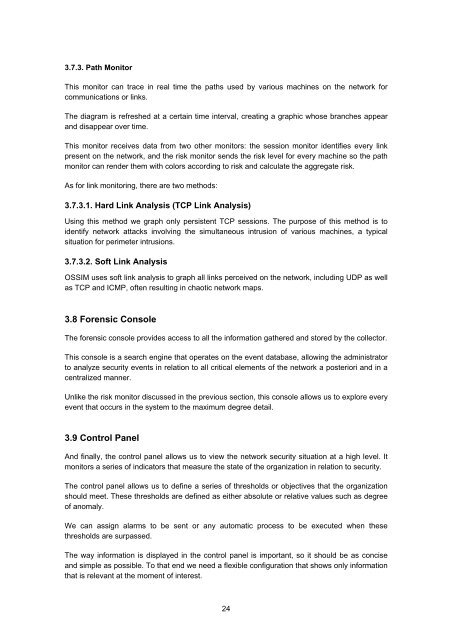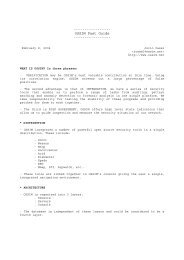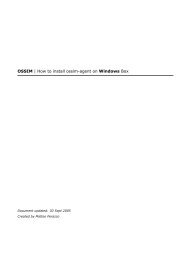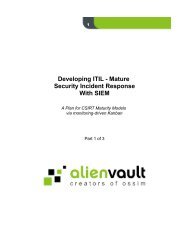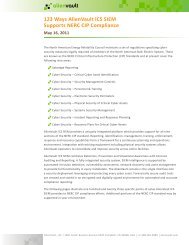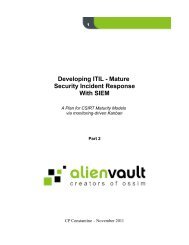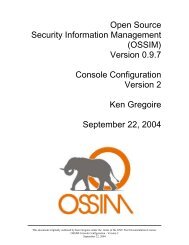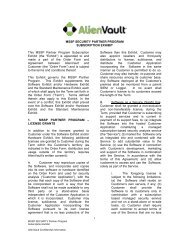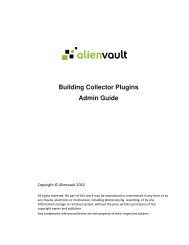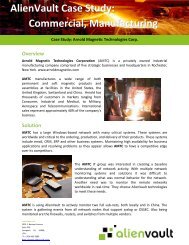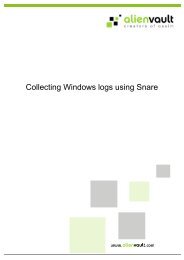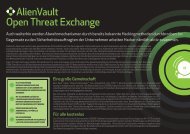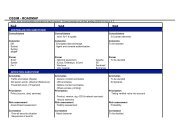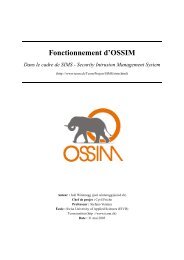ossim - AlienVault
ossim - AlienVault
ossim - AlienVault
Create successful ePaper yourself
Turn your PDF publications into a flip-book with our unique Google optimized e-Paper software.
3.7.3. Path Monitor<br />
This monitor can trace in real time the paths used by various machines on the network for<br />
communications or links.<br />
The diagram is refreshed at a certain time interval, creating a graphic whose branches appear<br />
and disappear over time.<br />
This monitor receives data from two other monitors: the session monitor identifies every link<br />
present on the network, and the risk monitor sends the risk level for every machine so the path<br />
monitor can render them with colors according to risk and calculate the aggregate risk.<br />
As for link monitoring, there are two methods:<br />
3.7.3.1. Hard Link Analysis (TCP Link Analysis)<br />
Using this method we graph only persistent TCP sessions. The purpose of this method is to<br />
identify network attacks involving the simultaneous intrusion of various machines, a typical<br />
situation for perimeter intrusions.<br />
3.7.3.2. Soft Link Analysis<br />
OSSIM uses soft link analysis to graph all links perceived on the network, including UDP as well<br />
as TCP and ICMP, often resulting in chaotic network maps.<br />
3.8 Forensic Console<br />
The forensic console provides access to all the information gathered and stored by the collector.<br />
This console is a search engine that operates on the event database, allowing the administrator<br />
to analyze security events in relation to all critical elements of the network a posteriori and in a<br />
centralized manner.<br />
Unlike the risk monitor discussed in the previous section, this console allows us to explore every<br />
event that occurs in the system to the maximum degree detail.<br />
3.9 Control Panel<br />
And finally, the control panel allows us to view the network security situation at a high level. It<br />
monitors a series of indicators that measure the state of the organization in relation to security.<br />
The control panel allows us to define a series of thresholds or objectives that the organization<br />
should meet. These thresholds are defined as either absolute or relative values such as degree<br />
of anomaly.<br />
We can assign alarms to be sent or any automatic process to be executed when these<br />
thresholds are surpassed.<br />
The way information is displayed in the control panel is important, so it should be as concise<br />
and simple as possible. To that end we need a flexible configuration that shows only information<br />
that is relevant at the moment of interest.<br />
24


